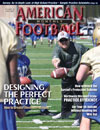Article CategoriesAFM Magazine
|
The Perfect Practiceby: Mike KucharSenior Writer, American Football Monthly © More from this issue Practice how you play. Perfect practice makes perfect. We’ve all heard the coaching axioms about preparation, and how important it is to practice efficiently. We hear them, but do we really listen? Just by simple word association, practice is tedious. To our players, it’s drudgery. Many of them simply go through the motions, “get through the practice”, and hold back until game day – which is why they signed up, after all.
|
|
|||||||
| HOME |
MAGAZINE |
SUBSCRIBE | ONLINE COLUMNISTS | COACHING VIDEOS |
Copyright 2025, AmericanFootballMonthly.com
All Rights Reserved





